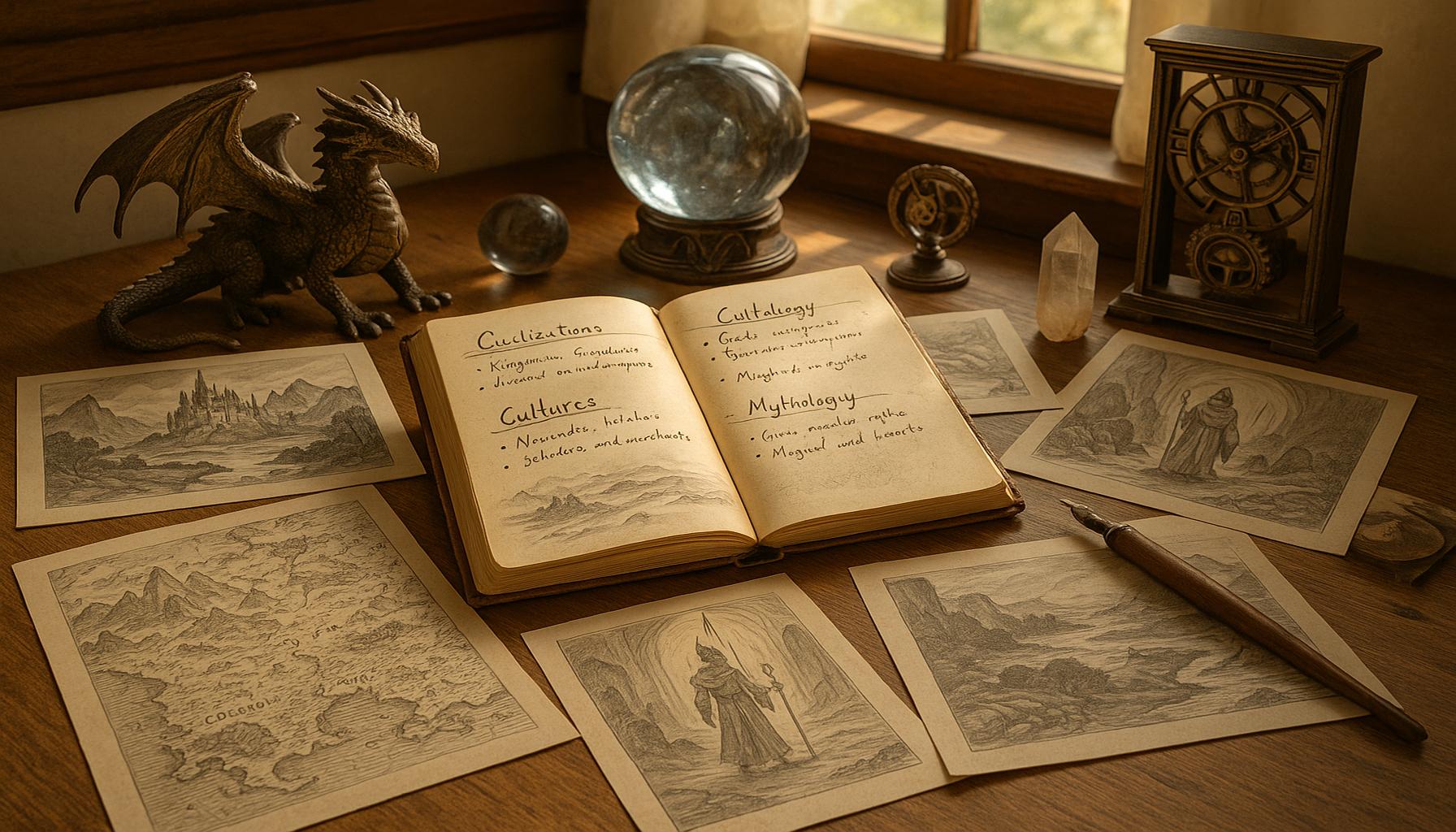The Art of Creative Writing: How to Turn Ideas into Captivating Stories

Unlocking the World of Creative Writing
Every great story begins with a simple idea, yet transforming that idea into a captivating narrative is where the true art lies. Creative writing is an intricate blend of inspiration, technique, and an understanding of audience dynamics. Here’s why this craft deserves your attention:
- Storytelling Power: Stories have been a cornerstone of human culture, reflecting our shared experiences and values. From ancient Greek tragedies to contemporary novels, powerful storytelling can shape societal norms and personal beliefs. For example, consider the impact of Harper Lee’s ‘To Kill a Mockingbird,’ which addresses themes of racial injustice and moral growth in America.
- Emotional Connection: Well-crafted stories have the ability to evoke profound emotions, making readers laugh, cry, or reflect on their own life experiences. A poignant example is John Green’s ‘The Fault in Our Stars,’ which explores love and loss through the eyes of young people facing terminal illness, leaving readers with a resonant sense of empathy and introspection.
- Imagination Expansion: Creative writing encourages imaginative thinking, opening the door to unique perspectives and innovative ideas. It allows writers and readers alike to challenge conventional thinking, such as in speculative fiction, where authors like Octavia Butler and Neil Gaiman explore alternate realities and speculative futures, pushing the boundaries of creativity.
As you dive deeper into this captivating world, you’ll discover essential tools for honing your craft. Understanding the components that contribute to effective storytelling is crucial for any writer. Consider the following key features:
- Character Development: Building relatable, dynamic characters helps engage readers. For instance, in J.K. Rowling’s ‘Harry Potter’ series, each character undergoes significant growth, allowing readers to form emotional connections with their journeys.
- Plot Structure: Understanding the elements of plot, conflict, and resolution is vital in maintaining interest. Classic story arcs, like the hero’s journey, provide a framework that has been successfully employed from ancient myths to modern bestsellers.
- Rich Descriptions: Vivid imagery and sensory details can transport readers into the world you create. Authors like Gabriel García Márquez, known for his magical realism, weave intricate descriptions that engage the senses, allowing readers to almost feel the settings come alive.
In the upcoming sections, we will explore practical strategies and insights that will guide you in transforming your thoughts into stories that resonate. We will delve into character arcs, effective dialogue, and world-building techniques. Prepare to uncover the artistic techniques that will shape your journey as a creative writer and help you craft narratives that leave a lasting impact.
DIVE DEEPER: Click here to explore the therapeutic power of sculpture
Essential Elements of Creative Writing
At the heart of creative writing is the ability to weave together distinct elements that not only captivate audiences but also breathe life into stories. Whether you’re a budding writer or a seasoned author, understanding these foundational components is crucial for any aspiring storyteller. Let’s delve into the essential elements that transform raw ideas into polished narratives that resonate with readers.

Character Development
Your characters are the driving force behind your story, and investing time in their development is paramount. A well-drawn character brings authenticity to your narrative and allows readers to form emotional connections. Consider the evolution of Elizabeth Bennet in Jane Austen’s ‘Pride and Prejudice’; her journey of self-discovery and romance is not just a plot point, but a powerful commentary on societal expectations and personal growth. To create compelling characters, contemplate the following aspects:
- Motivation: What does your character want, and what are they willing to do to achieve it?
- Flaws: Imperfections make characters relatable and valuable; they humanize them.
- Background: A character’s history shapes their worldview and influences their decisions.
By infusing your characters with depth and complexity, you’ll engage your readers and invite them to invest emotionally in the story.
Plot Structure
Every engaging narrative is underpinned by a well-structured plot. Understanding the nuances of plot structure can elevate your storytelling from conventional to exceptional. Exploring the classic elements of plot—exposition, rising action, climax, falling action, and resolution—can guide your narrative’s pacing and ensure that tension remains high throughout. For instance, in the beloved series ‘The Hunger Games’ by Suzanne Collins, the careful manipulation of suspense and revelation captivates audiences and encourages them to turn the page in anticipation.
Here are key elements to consider when constructing your plot:
- Conflict: Introduce central conflicts early on to propel the story forward and maintain reader interest.
- Rising Action: Build suspense through a series of challenges or setbacks that your protagonist faces.
- Climax: This pivotal moment is where tension peaks, and your characters face their biggest challenges.
Rich Descriptions
Another cornerstone of captivating storytelling is the use of vivid, evocative descriptions. Through well-crafted imagery, you can draw readers into the world you’ve created and allow them to experience the sights, sounds, and emotions of your narrative. Renowned author Toni Morrison is a perfect example; her rich prose and exquisite details elevate mundane settings into realms of lyrical beauty. Here are some tips for enhancing your descriptions:
- Use Sensory Language: Engage the five senses to immerse readers fully in your world.
- Show, Don’t Tell: Instead of stating facts, illustrate emotions and events through action and dialogue.
- Variety: Employ a mix of short and long sentences to create rhythm in your descriptions.
Mastering the trifecta of character development, plot structure, and rich descriptions will set the stage for compelling narratives that captivate your audience and evoke strong emotional responses. As you continue your journey in creative writing, keep these elements in mind, and prepare to embark on a transformative storytelling adventure.
The Foundations of Creative Writing
Understanding creative writing is crucial for anyone striving to weave compelling narratives. It’s not merely about putting words on paper; it’s about crafting emotionally engaging experiences that resonate with readers. One of the key foundations of this art lies in the development of character. Well-rounded characters serve as the backbone of any story, with their desires and conflicts driving the plot forward. Authors like Toni Morrison and Ernest Hemingway demonstrate how intricate character studies can yield profound insights into the human condition.
Plot Structure and Themes
Another pillar of great storytelling is plot structure. A well-defined plot arc not only captivates the audience but also makes them invested in the outcome. The traditional model, often referred to as the three-act structure, includes setup, confrontation, and resolution. Writers should also focus on the underlying themes of their narratives; strong themes can elevate a good story to greatness by providing depth and meaning.
Dialogue and Style
Effective dialogue is an essential component of creative writing. It can reveal character traits, and motivations, and propel the story. Striking the right balance between authenticity and style is what sets great writers apart. Consider studying dialogue in works by authors like J.D. Salinger, where each spoken word unveils layers of psychological complexity.
The Importance of Revision
Lastly, the art of revision cannot be overstated. The first draft is merely a starting point; refining your work is where the true magic happens. This is the phase where writers critically evaluate their choices and fine-tune their narratives to enhance clarity, flow, and emotional impact.
| Creative Writing Elements | |
|---|---|
| Character Development | Creates relatable and multidimensional personas that captivate readers. |
| Plot Structure | Ensures a coherent and engaging progression of ideas that keeps the audience invested. |
| Effective Dialogue | Conveys personality and tension, making stories feel alive and realistic. |
| Revision Process | Enhances clarity and quality, transforming a rough draft into a polished work. |
DISCOVER MORE: Click here to dive deeper into innovative painting techniques
Building Compelling Themes and Messages
While characters and plots form the backbone of your story, themes and messages elevate your narrative by adding depth and resonance. A powerful theme can take a story from being just engaging to profoundly affecting. Consider George Orwell’s ‘1984,’ where the theme of surveillance and totalitarianism serves as a cautionary tale that resonates with readers well beyond the pages of the book. To cultivate strong themes in your writing, focus on the following:
- Universal Concepts: Themes that explore love, loss, identity, and morality connect with readers on a fundamental level, creating an emotional bond.
- Subtext: Layer your narrative with subtext that invites readers to look deeper and interpret meanings that aren’t overtly stated.
- Conflict and Resolution: Use conflicts to illustrate your theme; the way a character overcomes challenges can reveal insights about life and human nature.
As you weave your themes into the fabric of your story, consider how they support character arcs and plot development. A well-integrated theme not only captivates but also invites reflection, making your writing memorable.
The Importance of Voice and Style
Your unique voice and written style function as your signature, distinguishing your work from others. A distinctive voice can inform how stories feel to the reader, contributing to tone, pace, and mood. For example, the electric prose found in the works of authors like Zadie Smith brings a vibrancy to contemporary narratives that resonates with a modern audience. Here’s how to cultivate your distinctive voice:
- Experiment: Don’t hesitate to try different styles or tones. Whether it’s humorous, melancholic, or lyrical, experiment with varying styles to discover what feels most authentic.
- Read Widely: Exposure to diverse voices can help you understand different styles, enabling you to form your own while being inspired by others.
- Consistency: Maintain your chosen voice throughout your work. This consistency can strengthen your narrative and create familiarity for your readers.
Engaging Dialogue
Dialogue is more than just characters exchanging words; it is a crucial element that drives action, reveals character, and builds tension. Authentic dialogue can breathe life into your characters and propel your story forward. When analyzing the impact of dialogue, one might look at the natural exchanges found in John Steinbeck’s ‘The Grapes of Wrath,’ where conversations authentically reflect the emotional struggles of the characters. To create compelling dialogue, keep these guidelines in mind:
- Listen: Pay attention to how people talk in real life. Note the rhythms, cadences, and idiosyncrasies of speech that can bring authenticity to your dialogue.
- Purpose: Ensure every line of dialogue serves a purpose. Whether it reveals something about the character or advances the plot, it should always contribute to the overall narrative.
- Subtext: Oftentimes, what isn’t said is just as important as what is. Use pauses, interruptions, and unsaid thoughts to create tension and intrigue.
Mastering themes, voice, and dialogue, along with character development, plot structure, and rich descriptions, will significantly enhance your storytelling abilities. As you write, keep these elements in mind to craft narratives that not only tell a story but resonate deeply with your audience.
LEARN MORE: Click here to discover the benefits of therapeutic knitting
Conclusion: Elevating Ideas into Exceptional Narratives
In the realm of creative writing, transforming mere ideas into captivating stories is an intricate dance of imagination and technique. By honing essential components such as compelling themes, a distinctive voice, and engaging dialogue, writers can craft narratives that not only entertain but linger in the minds of readers. Each element contributes to a greater whole, allowing themes to resonate, voices to evoke emotions, and dialogues to add authenticity.
As you embark on your creative journey, remember that every great writer starts with a simple idea. It is through the artful practice of character development, plot construction, and stylistic experimentation that you can breathe life into those ideas. Embrace the process; let your creativity flow unrestrained while applying the structural frameworks that enhance your storytelling. Reading widely and learning from various authors can broaden your perspective, allowing your unique voice to flourish within the literary landscape.
Ultimately, the goal of creative writing is not just to tell a story, but to forge connections with your audience. Whether it’s exploring universal themes or delving into complex characters, your words hold the power to inspire, provoke thought, and ignite change. So, venture forth into the world of storytelling, and let your imagination transform the ordinary into the extraordinary. Dive deeper, experiment boldly, and watch as the stories waiting within you come alive on the page.



